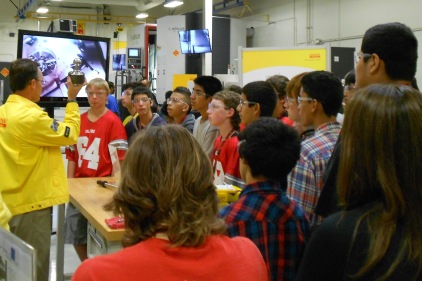On my 2014 calendar, I have already circled the first Friday in October, which is Oct. 3. That’s the date of the third annual Manufacturing Day in the United States. Several months ago I circled Oct. 4 on this year’s calendar—making sure I took part in the second annual event.
In the morning, I toured Carol Stream, IL-based Prince Industries Inc., which manufactures precision-machined and sheet-metal-fabricated components. Shortly thereafter, I visited a Sandvik Coromant productivity training center in Schaumburg, IL. There, engineers and technical specialists talked at length to high school seniors about manufacturing as a career.
Prince Industries didn’t participate in the inaugural Manufacturing Day, but made the decision early on in 2013 to take part this year. The event complements the company’s focus on recruiting youth into manufacturing.
“We have a recruiting program with several local high schools and technical schools,” notes Bob Morris, opportunity development manager for Prince Industries Inc. “In fact, last year nearly half of the people we hired for the production floor were recent high school graduates.”
Founded in 1959 by Edward K. Miller, Prince is a contract manufacturer that designs, develops and delivers precise components for industries as diverse as construction, dental, telecommunications and automotive.
The Carol Stream plant is the largest of three operated by Prince, according to Morris. Nearly 110 people work here, with another 50 working in Batavia, IL, and 130 working in Shanghai, China.
“The quality of products made in China is the same as that made here,” says Morris. “This is because the China plant uses similar equipment and production methods. About 80 percent of the products made there are sold there, and 20 percent are shipped here.”
Morris says the company produces from 10 to 20,000 components for each contract—although most orders range from 500 to 2,000. The Carol Stream building encompasses 80,000 square feet, including a manufacturing area of 53,000 square feet filled with lathes and other fabrication machines. Many operators oversea two machines.
Also on the production floor is a prototype department and an enclosed assembly area. Assembly includes manually inserting and tightening fasteners or using adhesives. During my visit, workers finalized assembly of a hydraulic pilot valve used in construction equipment.
“We aim to never have any work in progress because parts are made and placed immediately into boxes,” explains Morris. “Currently we’re running two 10-hour shifts, six days per week.”
When I arrived at Sandvik Coromant, more than 30 high school seniors were listening closely to how a $2 million Hofler HF 1000 machine mills gears for supersize wind turbines. The students became even more impressed when they got to climb up and stand inside this very large machine.
I soon learned from Jesus Nava, machining applications engineer for Sandvik Coromant, that gear milling was the second topic the students had learned about. First, the students were taught the basics of a CNC lathe and that Sandvit Coromant makes the cutting tooling for lathes and other such machines.
Tom Henry, manager of technical services, told the students about the importance of precision when making parts, and how and why modern manufacturing methods can produce such precision. He emphasized the need for skilled engineers to design—and skilled workers to operate—today’s complex machinery. Henry then demonstrated the capabilities of the nine-axis Mazak Integrex 200-IV, a multi-tasking CNC machine.
“Nearly everyone who works with these machines is good with their hands,” he admitted. “But what we need in manufacturing are people that are also good at computer programming and math. Our customers can’t find skilled people to run these types of machines. That’s the skills gap we’re hoping you can fill.”
I hope you took part in this year's Manufacturing Day. And I welcome your suggestions on what else our industry can do to promote the importance of U.S. manufacturing.


Recent Comments
Helpful for Trainees
Cable Assembly Manufacturers
Huawei for manufacturing?
should have a scanner and then 3D print the repair
IPC-A-610 and IPC-j-std-001